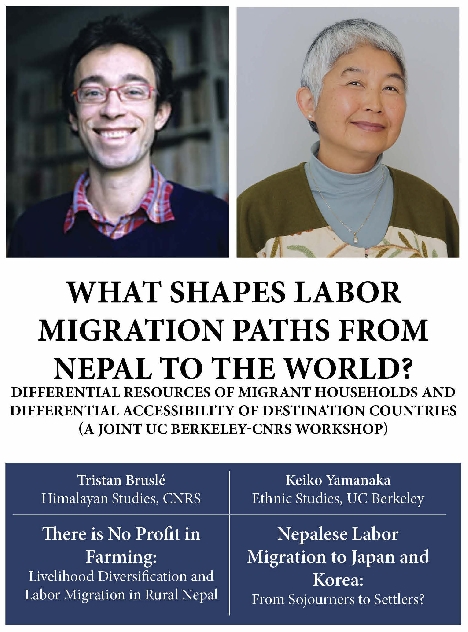Himalayan Studies at UC Berkeley in partnership with the Centre d'Etudes Himalayennes (CEH) of the National Center for Scientific Research (CNRS) in France, with funding support from the France Berkeley Fund, are proud to host a panel on the topic of migration. This is in continuation of the workshop hosted in Spring 2019 (for details see HERE) that brought together academics and graduate students from both institutions working on the Himalayan region in the Humanities and Social Sciences with the intent to explore specific forms of collaboration and lay the ground for developing research partnerships beyond.
With brisk and continuing demands for inexpensive and tractable workers, the global labor market has rapidly expanded from the Middle East to East Asia during the last few decades. This has been matched with fast-growing labor pools in the undeveloped economies struggling to provide employment to their bulging populations. Nepal is one of those countries that are recently inserted into the global labor market, which goes in pair with changing rural economies leading to the new ways of earning a livelihood. In the meantime, Japan and Korea, East Asian nations known for strict immigration policies despite their chronic labor shortages, have opened up borders for the foreigners to engage in the jobs shunned by citizen workers.
In this workshop, two researchers of Nepalese labor migration share results from their recent field studies. Based on surveys and conversations with former migrants and non-migrants in Southern Nepal, Tristan Bruslé (CNRS), examines the ways in which rural households navigate into wage-earning activities through migration. Flipping the side of the global economy, Keiko Yamanaka (UC Berkeley), reviews diverging immigration policies of Japan and Korea, which give rise to contrasting ways in which Nepali immigrants adjust to the changing law, market demands and societal perceptions in each host society.
ABSTRACTS
Tristan Bruslé, Center for Himalayan Studies, CNRS: There is No Profit in Farming: Livelihood Diversification and Labor Migration in Rural Nepal
Since the last twenty years, international labor migration from Nepal has exploded. More than half rural households now have a member working abroad, be it in India, in Malaysia or in one of the Gulf states. This insertion of Nepal in the global labor market goes in pair with changing aspirations of younger Nepalis leading to a transformation of ways of earning their living.
With the growing diversification of rural economies, the penetration of capitalism and the changing patterns of land-based relationships, working for money is sought after by most households. Access to cash is not only prized but almost necessary in every transaction as capitalism and consumer society have penetrated all economic spheres. The search for economic rationality based on profit (phaida), understood broadly as the positive result (i.e. cash) of an income generating activity, is now a common discourse held by many farmers and land owners. Given that agriculture is loosing attractivity, because there is no profit in farming, rural households tend to diversify their domestic economies in particular through a spatial scattering of household members. In this context, labor migration is just another opportunity for households to be able to minimize risks and/or to maximize incomes. But in an inequality ridden society, access to income diversification and economic capital improvement is highly differential, those at the upper end of the society being more able to decide where to allocate labor. I will then try to understand how labor migration is part of livelihood strategies of rural household, how households allocate labor and choose their occupation in the limited range of choices they have, differentiating between different classes of rural dwellers. Based on 215 questionnaires and multiple informal discussions with former migrants and non-migrants in the district of Sunsari (Southern Nepal), this communication intends to show how household navigate into wage-earning activities.
Keiko Yamanaka, Ethnic Studies, UC Berkeley: Nepalese Labor Migration to Japan and Korea: From Sojourners to Settlers?
International labor migration has increasingly become important to Nepalese households of all classes. Among the regions of labor receiving countries, East Asia occupies a unique position as desirable but difficult destinations for aspiring migrants. Japan and South Korea (Korea hereafter) represent two such examples. Similar to other labor-receiving countries of Asia, Japan and Korea aim to prevent permanent settlement of unskilled migrants, while employing them as temporary workers in the industries shunned by citizen workers. As recent countries of immigration, the two nations wish to preserve their social homogeneity, while reluctantly accepting foreign workers in the face of growing economic and demographic needs. Despite many common contexts of immigration, since the 2000s the two states have taken different policies of admission, employment and residence for unskilled migrants. In 2004 after intense national debates, Korea launched the Employment Permit System (EPS) by which migrants arrive to work for 4 years and 10 months with the rights and conditions equal to Korean workers. In spite of severe criticisms and profound changes taking place over the past 15 years, the program still remains to be the reliable, legal method for small employers to recruit, hire and retain their foreign work forces. In contrast, Japan continues to implement the Technical Internship Program (TIP) by which migrants engage in unskilled jobs as interns for up to five years. In April 2019, the government launched the Specific Technical Program (STP) by which migrants are admitted as workers in the selected 14 industries, although its effects remain to be unknown at this writing.
For Nepalese migrants, both Japan and Korea are attractive destinations. Since the 1990s the Nepalese have migrated to each country, laboring and residing as undocumented workers, international students, skilled employees and their dependents. In this study, I adopt the Nepalese as an example of labor migrants who seek in earnest a destination that allows them to secure high wages and stable residence. However, differing immigration policies of Japan and Korea provide them with contrasting ways for them to achieve their objectives and results. They also suggest rapidly shifting definitions of skills in policy making. Using published statistics, existing studies and interviews with migrants, activists, researchers and policy makers in Japan, Korea and Nepal, I examine history, ideology, policy and practice of Nepalese labor migration to Japan and Korea and explore possible reasons for diverging effects of the converging goals between the two East Asian nation-states.
PRESENTER BIOS
Tristan Bruslé, is a Researcher, at Centre d'Études Himalayennes, CNRS - Villejuif. As a geographer, his interests lie primarily in the spatial, social, and digital technology dimensions of labour migration; his research mainly focuses on the culture of migration. After his doctoral thesis which addressed the migration process among Nepalese people from western Nepal, he followed migrants to the Persian Gulf. The topics of study he has developed within the ANR TerrFerme project are: building a migratory imagination, being forced to integrate the host society, and spaces in everyday life. This research programme has also led him to reflect on migration policies in the Gulf countries from a spatial angle and from a critical geographical perspective. He is also interested in social and spatial stereotypes in the context of labour markets and in the extension of migrants living space. He has simultaneously developed research on the Nepalese diaspora in India (ANR Langues, cultures et territoires dans le Nord-Est indien) and on the Internet (ANR E-diaspora). Issues regarding this diaspora in the making, its actors, its power games or its mobilizing capacity is of particular interest to him. Further fieldwork within the ANR Terre-Eau project is scheduled in Nepal to assess the social, agricultural and spatial changes linked to mobility. Tristan Bruslé was on a long-term assignment in Bolivia during the period 2011-2015 during which he pursued his research on international labour migration by comparing Himalayan and Andean research.
Keiko Yamanaka is Continuing Lecturer of Ethnic Studies, University of California, Berkeley. She teaches courses on gender and generation in Asian American populations. She also teaches courses in Global Studies on immigration, citizenship and multiculturalism in Asia based on her research. Since the 1990s she has conducted research on diverse communities of new immigrant workers in Japan, including Nikkei Brazilians, unauthorized Nepalese, and Filipino immigrant wives. Focusing on civic support activities, she has been interested in how grassroots groups influence immigration policies in East Asia. More recently, she has extended her study to South Korea in comparison with Japan regarding impact of immigration policy on unskilled Nepalese migrants. Her recent publications include: Wind Over Water: Migration in an East Asian Context (2012, Berghahn Books, co-editor); Achieving Local Citizenship in Rural Japan: Filipina Wives in Organized Activism, in Yuk Wah Chan, David Haines and Jonathan Lee (eds.), 2014, The Age of Asian Migration: Continuity, Diversity, and Susceptibility, Cambridge: Cambridge Scholars Publishing; Diverging Paths, Converging Ends: Japan and Koreas Low-skilled Immigration Policies, 1990 to 2010, in John Lie (ed.), 2015, Multiethnic/Multicultural Korea, Berkeley: Institute of East Asian Studies (IEAS) Publications, University of California, Berkeley; Political and Social Contexts of Multiracial and Multiethnic Relations and Individual in Japan and South Korea, Asia and Pacific Perspectives, Vol. XIV, No.2, 2017, and In Asian American Studies, since 2002 in collaboration with her undergraduate students, she has edited a series of life history volumes titled, Biographies of Asian Immigrant Women and Men in America, catalogued in Berkeleys Ethnic Studies Library.
Event made possible with the support of the France Berkeley Fund and the Sarah Kailath Chair of India Studies
______
Like us on FACEBOOK
Follow us on TWITTER
For DIRECTIONS to the Institute please enter "Institute for South Asia Studies" in your google maps or click this GOOGLE MAPS LINK.
PARKING INFORMATION: Please note that parking is not always easily available in Berkeley. Take public transportation if possible or arrive early to secure your spot.
The event is FREE and OPEN to the public.

